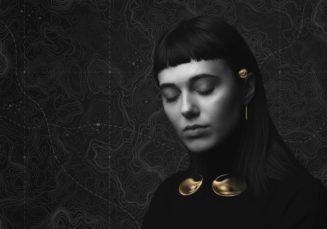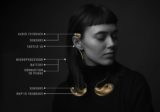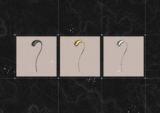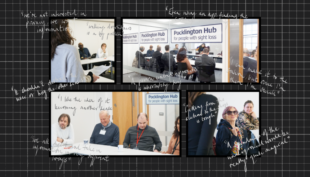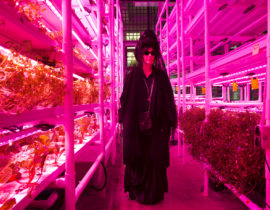i-D x ArtsThread recently announced the winners of the Global Design Graduate Show 2020 (GDGS). Below you can find my interview with Sophie Horrocks, the winner for Design for Social Good.
Sophie Horrocks is a human-centred designer and researcher who believes that design has the power to improve human quality of life, if the designer recognises the value of empathy-driven design rather than evidence-based. Her work promotes inclusion, accessibility through multi-sensory designs that go beyond just vision.
Her recent project, Sensuara “is an inclusive design solution to how blind and partially sighted people can navigate the world beyond vision. The wearable design proposes an integrated solution to enable detection, processing and feedback of environmental information needed for navigation. This allows independent, hands-free travel of indoor and outdoor spaces for blind and partially sighted people.”
Aybüke Barkcin: Sophie Horrocks, congratulations on your win for Design for Social Good at i-D x ArtsThread GDGS 2020. What motivated you to become a human-centred designer? How did the idea for Sensaura come about?
Sophie Horrocks: I think I’ve always had a fascination and curiosity to understand who we are as humans, how different contexts, cultures, and experiences shape who we are, how we live our lives, and how these components affect our happiness, health, and wellbeing. I think design is an intrinsic component of this. By designing our world with a human-centred design approach, I hope to ensure our environments positively impact our physical and mental health, particularly for those who can benefit most from it.
I started research into what would then become Sensaura about a year and a half ago – whilst studying my MA/MSc in Global Innovation Design at the Royal College of Art and Imperial College London. I was researching at the RNIB (Royal National Institute of Blind People) for a different project but whilst I was there, I met some incredible people who I ended up speaking to in great depth about some of the challenges they faced as people who were blind or partially sighted.
As my master’s continued abroad, whilst I studied internationally in Tokyo and New York, I continued meeting different people, blind and partially sighted users, charities, and technology companies who gave me an incredible overview of different challenges faced by this community. Having this time to meet such diverse people from across disciplines and cultures allowed me to recognise the issue of navigation as a global challenge still unresolved for this community. The synthesis of all this research was how Sensaura was born.
A.B: You have tested your design on people with sight loss, what were their reactions and experiences towards Sensaura?
S.H: Yes, a key aspect of the project was to take a participatory approach to the design process. This meant not only testing the design with users but integrating their perspectives throughout the design process. This varied from running focus groups, having 1-1 consultation sessions to running feedback sessions.
Testing the final design/ experience was challenging during Covid-19 as the experience is very much centred around having a real-world scenario in which to test within. However, running simulation experiences gave promising reactions from users – with some saying it gave them a feeling of having an “extra sense”.
A.B: In your work, you believe that design can improve the quality of life and you talk about the importance of recognising empathy-driven design rather than evidence-driven. Can you elaborate on what this means to you?
S.H: For me, design and research are so closely intertwined. What I mean by recognising empathy-driven and not just evidence-based design is essentially to research and carry out designs with both our head and our hearts. It sounds simple, but I think in practice it can sometimes be forgotten. There will never be the perfect approach – of balancing rigour with intuition – but maintaining conscious awareness of how you’re approaching the research and design process is crucial, in my eyes, to designing solutions which can create impact.
A.B: Who are some of the people that had an impact on you and your work?
S.H: I think for me, my work is always elevated when I gain insights and feedback from people far beyond my “field” within design. Whilst working on Sensaura, I collaborated with computational designers, musicians, radar researchers and charities for blind and partially sighted communities. Combined with consultations with specialists across urban planning, neural interface design and interaction design gave a holistic overview of the problem area I was working within. Without a doubt, this had a hugely positive impact on what I was able to achieve and the outcomes of the research.
A.B: When I was researching Sensaura, you included a page referring to “sensory augmentation” which I had never heard of before. It talks about how our experience with data today is only restricted to our sight, but in the future, there may be technologies which allow us to feel data. How do you see the future?
S.H: I think there has long been a dominance and reliance on visuals driving communication, information and emotional experiences. For me though, there is so much value from taking a multi-sensory approach to design – touch, sound, smells and something or other are as important as sight. Not only does this hugely benefit issues of inclusion, but also creates more memorable, emotive and immersive experiences – something that brands are becoming more aware of in terms of marketing and customer-experiences. However, I feel this is still in its infancy and there is so much more that can be achieved if we apply this thinking to other areas of research, interaction and environment design.
There is already so much evidence of us pivoting towards a more audio-centric future – from home integrated voice-assistants, the rise of audiobooks and handsfree audio devices. If we continue this approach and look at not just designing more audio-based interactions but also tactile and olfactory experiences, I think there are huge benefits to be gained.
A.B: Thank you Sophie for your time and good luck on your future projects.
To learn more about Sensaura and Sophie’s work, you can go to the link: https://www.artsthread.com/profile/sophiehorrocks/

